- Home /
- Mechanical Calculators /
- Classification
Classification
Direct Drive
Sliders
Wheels
Dials
Semi-Direct Drive
Sliders
Wheels
Dials
Buttons/Keys
Indirect Drive
Stepped Drum mechanism
Pinwheel mechanism
Other wheel mechanisms
Toothed rack mechanisms
Other mechanisms
The various adding machines and calculators can be categorised in many ways - by size,
complexity, input method, mechanism, etc. Below I set out the various categories that
I feel are the most relevant, with examples of each category from my collection. Note
that not every calculator will be listed here, so for the complete list you need to
visit the main Mechanical Calculators Page.
Direct Drive
A Direct Drive machine is one where the parts that display the digits of the result register are
directly manipulated by the user. These are the simplest type of adding machines, in that they
essentially consist only of a single register, often with a carry mechanism.
This category can be further subdivided by the input method used, which can be sliders,
wheels, or dials.
Sliders
The classic example of this type are Addiators, i.e. Troncet adders, such as the
Pocket Adding Machine. The sliders that you push up or down
also act as the register display.
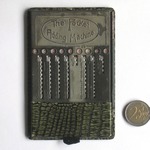 Pocket Adding Machine
Pocket Adding Machine
Wheels
On this type of machine the register consists of a set of wheels next to
each other on the same axle. The Addimat / Schnellrechner
is the obvious example. I consider the Golden Gem to be a direct
drive adder with wheels, because its chains are essentially just extensions of the number
wheels. A chain acts like a large flattened wheel that you manipulate.
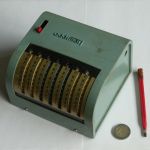 Addimat
Addimat
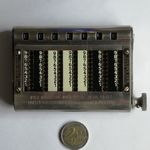 Golden Gem
Golden Gem
Dials
Dials are wheels on an axis that is pointed towards you, so you have to do a circular motion to
turn them. There are many dial adders such as the Calcumeter,
Dial-A-Matic, Stephenson's adder,
and the Kes-add.
I would also include the Lightning Adding Machine, because its number
wheels are directly and constantly connected to the dials. The dials do not have to be the same
size, see for example the Webb Adder, and can be concentric, like in the
BriCal.
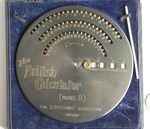 British Calculator
British Calculator
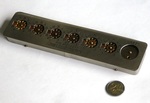 Calcumeter
Calcumeter
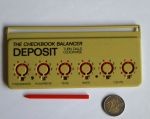 Checkbook Balancer
Checkbook Balancer
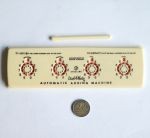 Sterling Dial-A-Matic
Sterling Dial-A-Matic
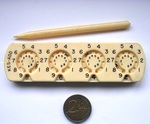 Kes-Add
Kes-Add
 Lightning Adding Machine
Lightning Adding Machine
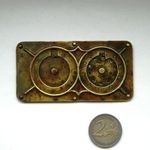 Stephenson Adding Machine
Stephenson Adding Machine
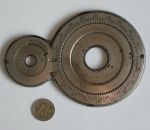 Webb Adder
Webb Adder
Semi-Direct Drive
An adding machine has Semi-Direct Drive when the results register digits are updated
during the input of a number, but the input and the register are not continually
connected. There is usually some kind of ratchet system between the two to allow the
input mechanism to return to its initial state without undoing the changes that were
made to the register. It is also possible that the ratchet system is in effect while
setting the input, and that the transfer to the register happens when the input is
cleared. Note that on machines in this category the input cannot be retained for
repeated additions, because the either the setting or the clearing of the input
drives the register directly.
This category can also be further subdivided by the input method used. In addition to
sliders, wheels, and dials, this category also allows buttons or keys to be used.
Sliders
The best known example of a machine with semi-direct drive and input through sliders
is the Comptator / Rapid Computer, but there is also the
SuN, and the Stima.
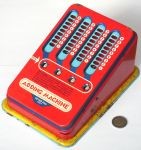 Peter Pan Adding Machine
Peter Pan Adding Machine
 Rapid Computer
Rapid Computer
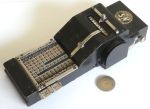 The SuN Adder
The SuN Adder
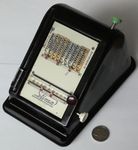 Stima
Stima
Wheels
The Resulta E7 is a good example of this type. Its predecessor,
called the Minerva was still an adder with direct drive as it did not have a separate input
register. The Triumphator KA also falls into this category,
because its input levers are just a way of turning the wheels of the input register.
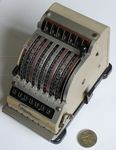 The Resulta E7
The Resulta E7
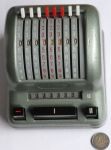 The Triumphator KA
The Triumphator KA
Dials
The only example of a semi-direct adding machine that uses dials is the Conto.
Note that it adjusts the main register when the input dials are cleared rather than when
the input is performed.
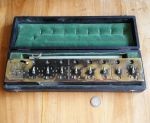 Conto C
Conto C
Buttons/Keys
Key-driven adding machines fall into this category. The register is updated during either the downstroke
or the upstroke of a key. Examples of this type are the Burroughs Calculator,
the Comptometer, Sumlock and Plus Adders,
the Direct II and the Contex A/B. There are also
small counting machines with buttons, such as the Aderes, the Alexe,
the Benton Tally Register, the Denominator, and
the Pocket Counter.
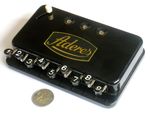 Aderes
Aderes
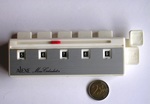 The Alexe Mini Calculator
The Alexe Mini Calculator
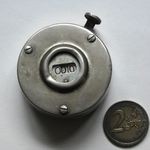 Benton Tally Register
Benton Tally Register
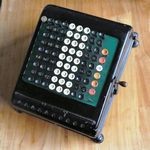 Burroughs Calculator
Burroughs Calculator
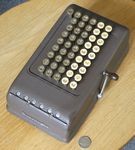 Baby Burroughs Calculator
Baby Burroughs Calculator
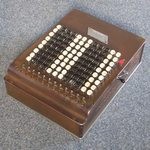 Comptometer E
Comptometer E
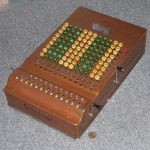 Comptometer ST
Comptometer ST
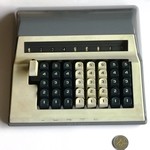 Contex B
Contex B
 The Denominator
The Denominator
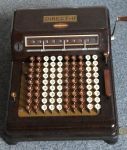 Direct II
Direct II
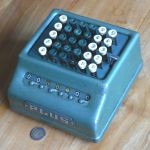 Plus Adder
Plus Adder
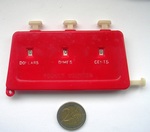 The Pocket Counter
The Pocket Counter
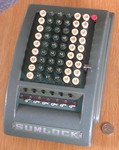 Sumlock 906
Sumlock 906
Indirect drive
With this type of machine the input is separate from the results register, and only applied by
turning a crank or pulling a lever, whether by hand or by electric motor. The input is retained so
that it can be added repeatedly, allowing for small multiplications. If the register and the input
can shift relative to each other, then larger multiplications can be performed too. That makes
these machines fully fledged calculators as opposed to adding machines.
In these machines the input method is not as important as the way the input is then transferred
during operation. The registers generally have number wheels, so the input of a digit 0-9 needs
to be converted to a varying amount of rotation. How this conversion is done gives a good way
to further categorise these machines. These mechanism categories are unique to these indirect
drive machines and are mostly not applicable to the semi-direct or direct types of adding machine.
The two most common and well-known mechanisms are the stepped drum, and the pinwheel.
Stepped Drum
The stepped drum was first successfully used in a calculator by Leibniz, but it wasn't until Thomas
de Colmar's Arithmometer that stepped drum machines were produced in larger numbers. Consider one
gear, driving another gear of the same size. One revolution of the first gear causes one revolution
of the second. If you were to remove the teeth from one half of the first gear, then a full revolution
would only cause half a revolution of the second gear.
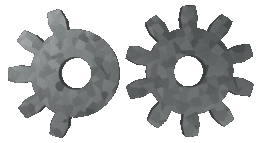
Now imagine that you have an axle on which
there are ten gears, each with a different number of teeth, ranging from zero to nine. So you have
one "gear" with no teeth, one gear with only one tooth, one with two teeth, and so on until the one
with nine teeth. All of these are next to each other on a shared axle. On a parallel axle you have
another gear, but you can slide it so that it can interact with any one of the ten gears on the first
axle. In this way you can use a sliding motion to select how much the second axle is to be turned by
the first axle. A stepped drum is essentially the set of ten gears on the first axle, but fused together
into a single object. In its simplest form it is a cylinder with ridges of different lengths, but parts
of the cylinder where there are no ridges can be cut away to reduce weight.
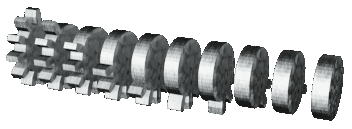
In the Thomas Arithmometer and its descendants such as the Unitas and the
Archimedes, there is one stepped drum for each digit of the input. The input is through a slider or
keyboard, and it sets the position of the gear that is driven by the stepped drum. It is of course
also possible to move the stepped drum relative to a fixed gear. This even allows the stepped drum
to be made of two halves, one half whose number of teeth range from 0 to 4, and the other half which
is set to supply either 0 or 5 extra teeth. This is done in the Monroe
calculators.
Stepped drums tend to be bulky, causing the register digits to be spaced far apart. The
Rheinmetall avoids this by having two digits share a single
stepped drum. An entirely different stepped drum design is used in the Curta.
This drum is shared by all the input digits, which are arranged at regular intervals around the drum.
Instead of ridges, the Curta's drum has small pins, similar to what you would see on a cylinder of a music box.
The drum has 20 different tracks, alternating between adding and subtracting, one pair of tracks for
each digit. Pulling the crank up for subtraction mode simply shifts the drum by one step, shifting
from the additive tracks to the subtractive ones.
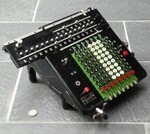 Rheinmetall D II a
Rheinmetall D II a
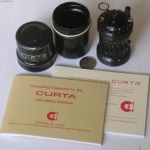 Curta Type I
Curta Type I
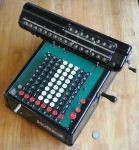 Monroe Model K
Monroe Model K
 Unitas
Unitas
Pinwheel
The pinwheel first became commercially successful with the machine designed by Wilgott Odhner. Although
there were previous attempts to use the mechanism going back almost two centuries, only a few machines
had been constructed using the principle.
A pinwheel is a gear with teeth that are retractable or extendable. Usually it has a lever attached
to it that the user can move to select how many teeth the pinwheel gear has, ranging from 0 to 9 teeth.
The pinwheel has the disadvantage that when the pinwheel is turned, the setting lever turns with it.
This means that there should be some kind of locking system to ensure the setting lever does not get
moved inappropriately when the wheel turns. But more than that, the setting lever usually is short and
thin because it has to go inside the body of the machine. Examples of these are the
Brunsviga, Minerva,
Original-Odhner, and Walther.
Some machines were made that had setting levers that disconnected from the pinwheels when the crank was
turned, for example the Melitta. There are also machines that use
an external keyboard to set the pins of the pinwheel, and Facit machines are a
good example of this.
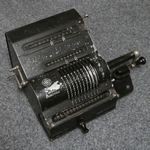 Brunsviga Nova II
Brunsviga Nova II
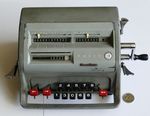 The Facit C1-13
The Facit C1-13
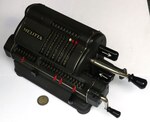 Melitta VII/16 calculator
Melitta VII/16 calculator
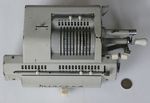 Minerva
Minerva
 Original-Odhner
Original-Odhner
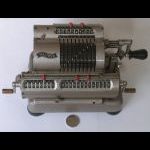 Walther RMKZ
Walther RMKZ
Other wheel mechanisms
The pinwheel allows you to select the number of teeth that are present on the gear,
and once set this then remains constant while the crank or motor turns. There are
other mechanisms in which pins are set during the rotation.
One way is to have a fixed camwheel with a setting lever with which the profile of the cam wheel can
be changed. The rotating gear wheel next to it has a cam follower that changes the behaviour of the
gear wheel as it goes through the rotation. The Hamann Manus has wheels in which the teeth are on a
ring that becomes connected or disconnected as the axle rotates ("switching latch" or
"latched gear" mechanism). The Marchant XL has wheels in which a toothed section is
retractable during part of the rotation ("adapting segment" mechanism). The Numeria and
the Kuhrt both use pins that can move sideways by a cam, though their implementation is very
different.
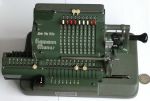 The Hamann Manus F
The Hamann Manus F
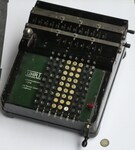 Kuhrt A2
Kuhrt A2
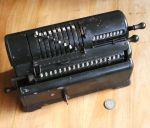 Marchant XL
Marchant XL
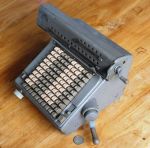 Numeria 7101
Numeria 7101
Toothed rack mechanisms
Instead of a wheel in which we select the number of teeth, it is also possible to have a linear rack
with a variable number of teeth. That is what happens in the Thales KA - each
key column is a rack, and the state of each key adds or removes one tooth. Pressing the lever pulls
the number wheels along the racks, turning them appropriately. On the return journey the wheels travel
at a lower height along a second set of racks which handle carries between the wheels.
One could also have a rack with a fixed number of teeth, but simply vary the distance that the rack
moves to get the amount of rotation corresponding to each digit. The Brunsviga
90 KA has toothed racks that are pulled until they are blocked by barriers that were set up by pressing
input keys on the keyboard. The Corema uses something similar. The
Contex 10 uses a curved rack at one end of a lever, and the other end of the
lever travels until it hits a pin that was set up by pressing a digit key.
Lastly, the Mercedes-Euklid has 10 parallel racks that move different amounts as a replacement
for a stepped drum. It uses axles with gears that can slide along the axle and in this way select
which toothed rack to engage with.
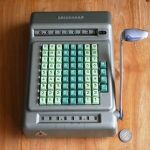 Brunsviga 90 TA
Brunsviga 90 TA
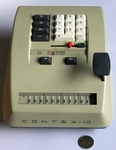 Contex 10
Contex 10
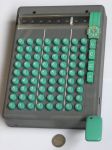 Corema Portative MC 15
Corema Portative MC 15
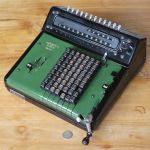 Mercedes Euklid
Mercedes Euklid
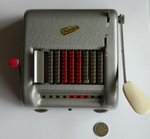 Thales KA
Thales KA
Other mechanisms
The only mechanism I know of that does not fall into any of the above categories is
the one used in the later Marchant calculators, such as the Silent Speed and
Figurematic models. Instead of a stepped drum for each digit, there is a 10-speed
gearbox. Unlike all other calculators, this makes the number wheels turn at different
speeds, but for the same length of time. Combining this with a carry mechanism that is
a simple 10:1 gear ratio, the number wheels turn directly to the answer in one smooth
motion instead of the start-stop motion of other machines.
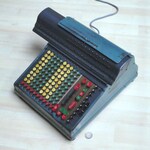 Marchant ACT-10M
Marchant ACT-10M
© Copyright 2019-2024 Jaap Scherphuis, mechcalc a t jaapsch d o t net.
 Pocket Adding Machine
Pocket Adding Machine
 Addimat
Addimat
 Golden Gem
Golden Gem
 British Calculator
British Calculator
 Calcumeter
Calcumeter
 Checkbook Balancer
Checkbook Balancer
 Sterling Dial-A-Matic
Sterling Dial-A-Matic
 Kes-Add
Kes-Add
 Lightning Adding Machine
Lightning Adding Machine
 Stephenson Adding Machine
Stephenson Adding Machine
 Webb Adder
Webb Adder









































